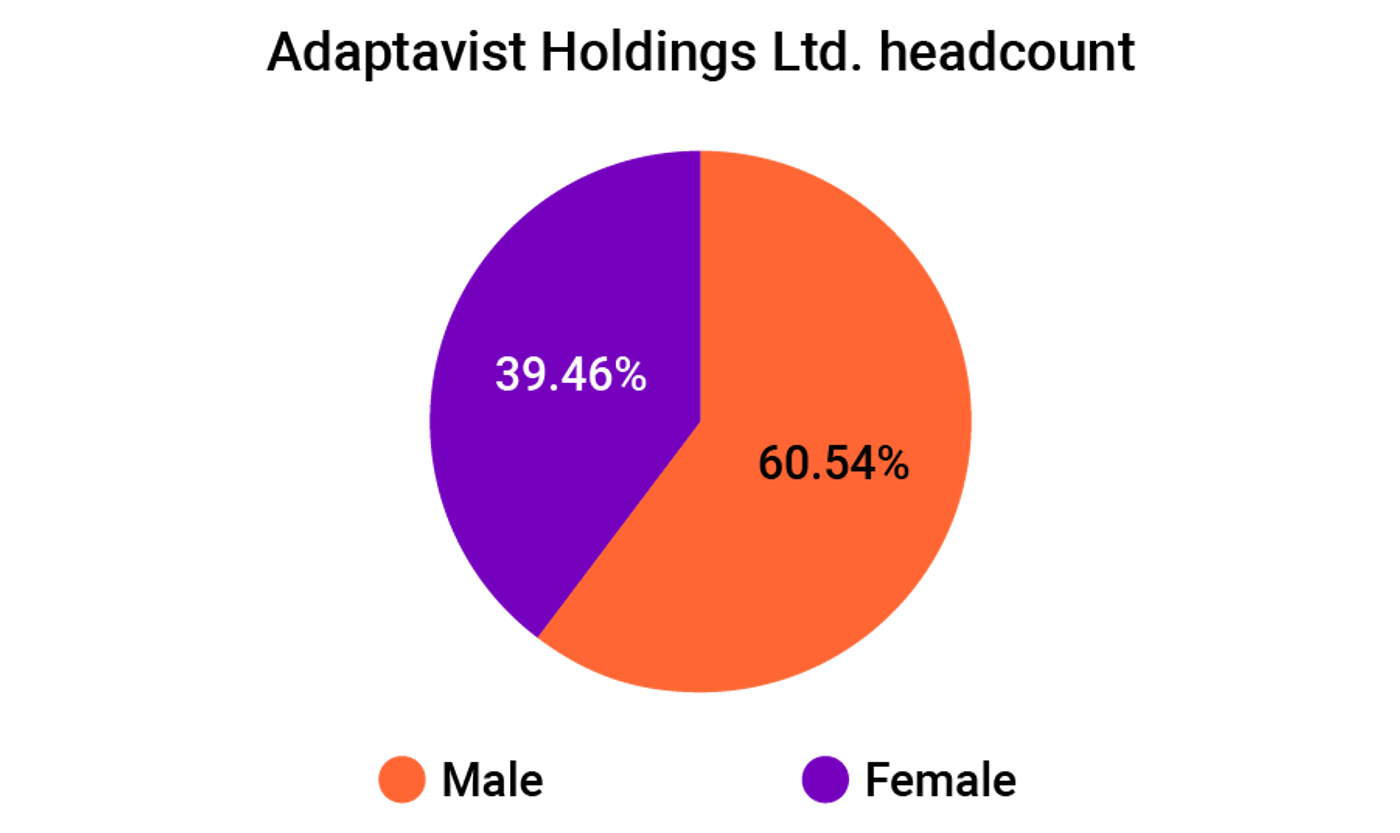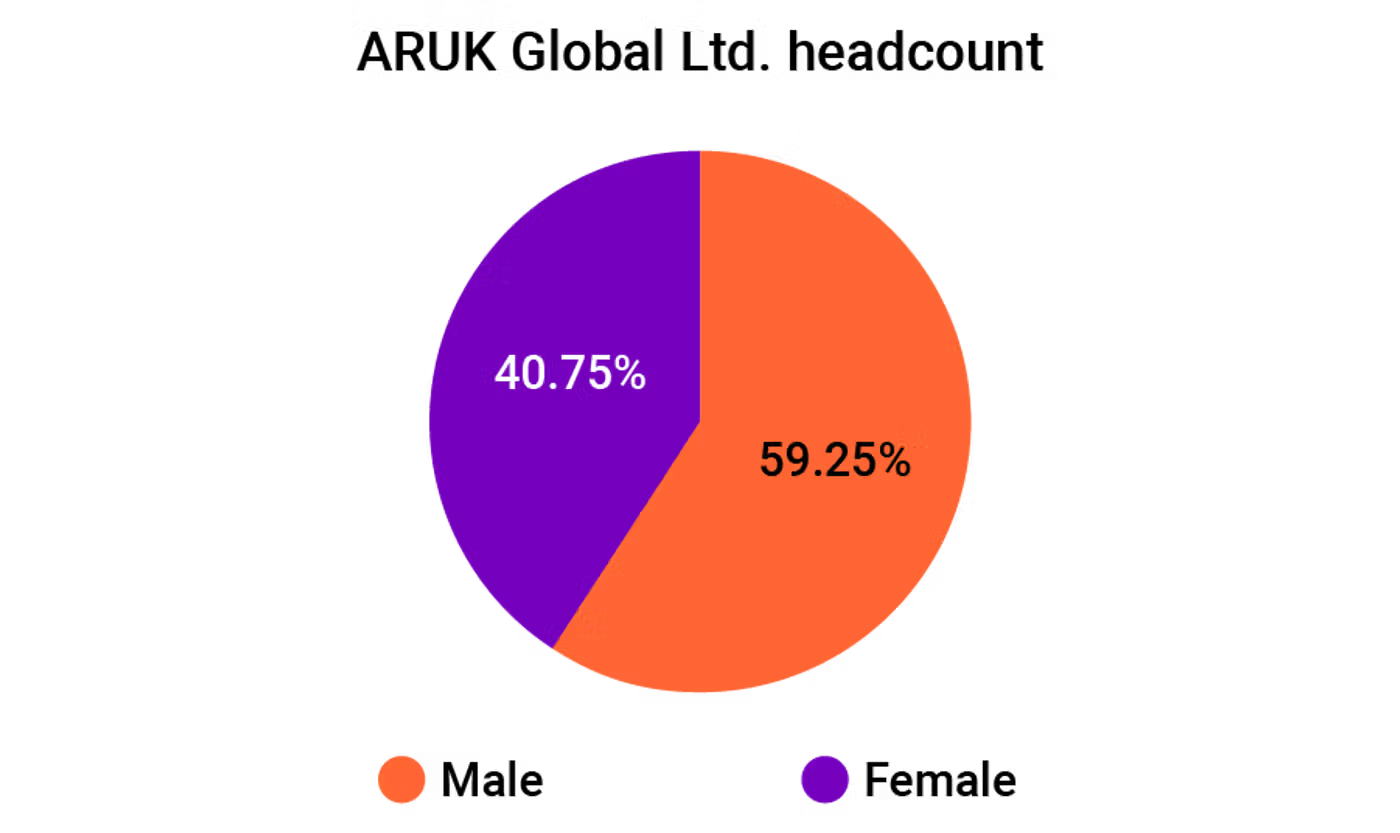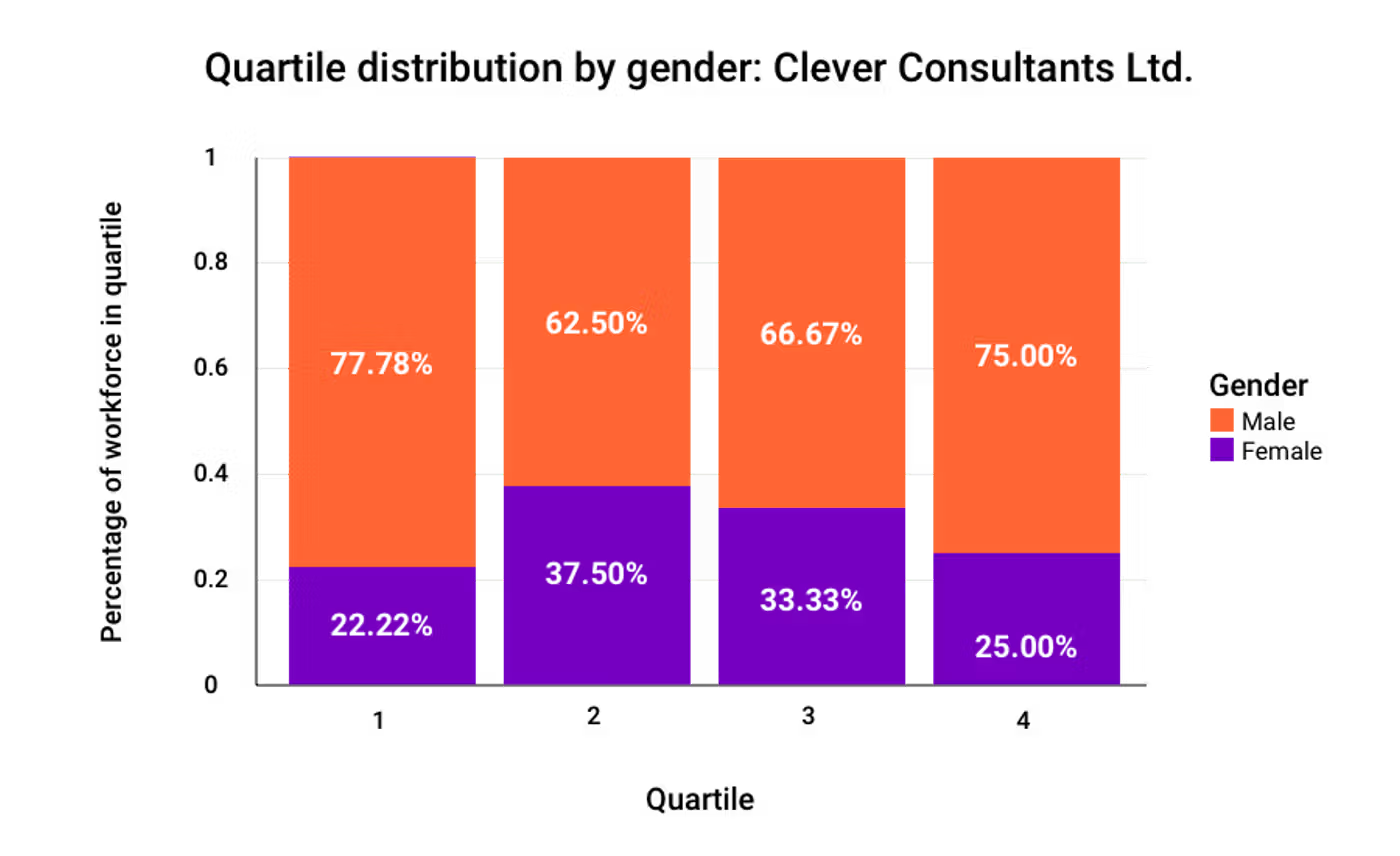UK gender pay gap reporting 2023
Our annual gender pay gap report for UK employees is a snapshot of where we are and where we are aiming for as we strive for a more equitable future.
Understanding where we are right now
As we continue to grow, so does our responsibility, so today, we release our first-ever gender pay gap report. To show the full picture of our UK employees, you'll see data for ARUK Global Ltd. and Clever Consultants Ltd. (Brew Digital), with an overview of the two entities together as Adaptavist Holdings Ltd. Based on our UK employees in 2023, the data has revealed we have some distance to go to improve the pay gap for our female employees.
It is important to highlight that we do not pay people differently based on their gender. Instead, we see that the tech industry's persistent gender skills gap is largely driving the widened disparities in earnings between genders, a challenge we're resolute in addressing.
The team has already begun efforts to improve the gender pay gap, and we are taking steps across the entire employee lifecycle to bring lasting change.
Our organisation should be a welcoming and inclusive place for everyone, yet we have the humility to accept that more must be done to achieve that fully. While acknowledging the existing gap, we're committed to its eradication—not solely for our present workforce but for the aspiring women who'll join the tech industry tomorrow. We are taking pragmatic steps to use the data in this report and other business findings to hold ourselves accountable for improving and creating an environment in which we can all thrive.
Simon Haighton Williams, CEO, The Adaptavist Group
What is the gender pay gap?
The gender pay gap report is an analysis that examines the disparity in average earnings between men and women within an organisation. It is a crucial tool for identifying and addressing gender inequalities in the workforce. Any employer with 250 or more employees on 5 April each year must report their gender pay gap data.
It shows the difference in the average pay between male and female employees. The figure is affected by how many of each gender are at a given grade, department, and their position on the pay scale.
Pay gap vs equal pay
Distinguishing between the gender pay gap and unequal pay is essential. Unequal pay, prohibited by the Equal Pay Act since 1970, refers to giving women less pay than men for identical work.
Gender pay gap vs gender equality
Gender pay gap
This term refers to the difference in average earnings between men and women across the whole organisation or across industries. It's a measurable indicator of gender disparities in the workforce, highlighting areas where women may be underrepresented or underpaid compared to their male counterparts.
Gender equality
While the gender pay gap is a symptom of gender inequality, achieving gender equality involves addressing broader systemic issues beyond pay differentials. It encompasses fair treatment, representation, opportunities for advancement, and dismantling barriers that hinder women's progress in the workplace, including education and training.
Numerical definitions
Mean:
This is the total sum of all wages divided by the number of employees. It provides a snapshot of the 'average' wage within a group. However, outliers or extreme values can skew this figure, meaning it can be less representative of the overall earning pattern due to outliers, i.e., high or low salaries.
Median:
Unlike the mean, the median is the middle value when all wages are arranged in ascending order. It gives us a more robust understanding of the typical earnings, as it's less influenced by extreme values.
Average:
The term average is ambiguous and can refer to either mean or median but is most often used interchangeably with the mean. If you see the term average used throughout this report, we are referring to the mean if you see the average in our report.
Reporting, methodology, and timeframe
The full methodology for how employers should prepare their data can be found here for those who want to dive into the details. The data for Adaptavist Holdings Ltd. represents a combination of all eligible employees based in the UK across various business units and teams. This report is prepared in accordance with the government requirement for the snapshot data on 5 April 2023.
Why do we have three data sets represented in our gender pay gap reporting?
We have more than one legal entity in the UK. Our UK employees are employed by either ARUK Global Ltd. or Clever Consultants Ltd. (Brew Digital).
Our annual gender pay gap report for UK employees is a snapshot of where we are and where we are aiming for as we strive for a more equitable future. The report shows data from ARUK Global Ltd. and Clever Consultants Ltd. and then displays the combined data from both entities under Adaptavist Holdings Ltd. to show a complete picture of our data for all UK employees.
UK gender pay gap report findings
Below are the outcomes of the UK gender pay gap reporting:
(1) Adaptavist Holdings Ltd. (all UK employees)
(2) ARUK Global Ltd. and
(3) Clever Consultants Ltd. (Brew Digital)
(1) Adaptavist Holdings Ltd. employee data
On 5 April 2023, there were 299 employees at Adaptavist Holdings Ltd. that met the requirements to be included in the gender pay gap calculation:
- 39.46% of these employees were female
- 60.54% of these employees were male

Hourly pay gap
| Gender pay gap | ||
|---|---|---|
| Mean | 24.71% | |
| Median | 22.93% |
The data shows that women earn 77.07p for every £1 that men earn when comparing median hourly pay. Their median hourly wage is 22.93% lower than men's. When comparing mean (average) hourly pay, women's mean hourly wage is 24.71% lower than men's.
The percentage of women in each pay quarter
Quartile data
The quartiles represent our pay, which has been split into four equal bands from the lowest hourly pay (quartile 1) to the higher upper hourly pay (quartile 4). Women occupy 18.92% of the highest hourly paid jobs and 57.33% of the lowest hourly paid jobs.
| Pay quartile | Percentage of females | Percentage of males |
|---|---|---|
| All employees | 39.46% | 60.54% |
| Lower | 57.33% | 42.67% |
| Lower middle | 50.67% | 49.33% |
| Upper middle | 30.67% | 69.33% |
| Upper | 18.92% | 81.08% |
If the quartile percentages were more reflective of the total employee percentage of males and females (i.e. 39.46% female and 60.54% male), the gender pay gap would be reduced.

* Each quartile contains about 75 employees.
Bonus pay gap
| Measure | Average type / gender | Female % lower than male / workforce % |
|---|---|---|
| Bonus pay gap | Mean | 35.09% |
| Median | 28.12% | |
| % employees receiving a bonus | Male | 75.71% |
| Female | 76.23% |
Women earn 71.88p for every £1 that men earn when comparing median bonus pay. Their median bonus pay is 28.12% lower than men's.
(2) ARUK Global Ltd. employee data
On 5 April 2023, there were 265 employees that met the requirements to be included in the gender pay gap calculation:
- 40.75% of these employees were female
- 59.25% of these employees were male

Hourly pay gap
| Gender pay gap | ||
|---|---|---|
| Mean | 27.92% | |
| Median | 24.29% |
The data shows that women earn 75.71p for every £1 that men earn when comparing median hourly pay. Their median hourly wage is 24.29% lower than men's. When comparing mean (average) hourly pay, women's mean hourly wage is 27.92% lower than men's.
The percentage of women in each pay quarter
Quartile data
The quartiles represent our pay, which has been split into four equal bands from the lowest hourly pay (quartile 1) to the higher upper hourly pay (quartile 4). Women occupy 15.15% of the highest hourly paid jobs and 70.15% of the lowest hourly paid jobs.
| Pay quartile | Percentage of females | Percentage of males |
|---|---|---|
| All employees | 40.75% | 59.25% |
| Lower | 70.15% | 29.85% |
| Lower middle | 41.42% | 57.58% |
| Upper middle | 34.85% | 65.15% |
| Upper | 15.15% | 84.85% |
If the quartile percentages were more reflective of the total employee percentage of males and females (i.e. 40.75% female and 59.25% male), the gender pay gap would be reduced.

* Each quartile contains about 66 employees.
Bonus pay gap
| Measure | Average type / gender | Female % lower than male / workforce % |
|---|---|---|
| Bonus pay gap | Mean | 37.53% |
| Median | 26.15% | |
| % employees receiving a bonus | Male | 77.12% |
| Female | 76.58% |
Women earn 73.85p for every £1 that men earn when comparing median bonus pay. Their median bonus pay is 26.15% lower than men's.
(3) Clever Consultants Ltd. (Brew Digital) employee data
On 5 April 2023, there were 34 employees that met the requirements to be included in the gender pay gap calculation:
- 29.41% of these employees were female
- 70.59% of these employees were male

Hourly pay gap
| Gender pay gap | ||
|---|---|---|
| Mean | -4.88% | |
| Median | -1.08% |
The data shows that women earn £1.0488 for every £1 that men earn when comparing median hourly pay. Their median hourly wage is 1.08% greater than men's. When comparing mean (average) hourly pay, women's mean hourly wage is 4.88% more than men's.
The percentage of women in each pay quarter
Quartile data
The quartiles represent our pay, which has been split into four equal bands from the lowest hourly pay (quartile 1) to the higher upper hourly pay (quartile 4). Women occupy 25% of the highest hourly paid jobs and 22.22% of the lowest hourly paid jobs.
| Pay quartile | Percentage of females | Percentage of males |
|---|---|---|
| All employees | 29.41% | 70.59% |
| Lower | 22.22% | 77.78% |
| Lower middle | 37.50% | 62.50% |
| Upper middle | 33.33% | 66.67% |
| Upper | 25.00% | 75.00% |

* Each quartile contains about nine employees.
Bonus pay gap
| Measure | Average type / gender | Female % lower than male / workforce % |
|---|---|---|
| Bonus pay gap | Mean | 18.01% |
| Median | 25.53% | |
| % employees receiving a bonus | Male | 66.67% |
| Female | 72.73% |
Women earn 81.99p for every £1 that men earn when comparing median bonus pay. Their median bonus pay is 25.53% lower than men's.
Why do we see some of these differences?
It is undeniable that we have, at the snapshot date, more men than women in our UK workforce. While across the broader business, we have departments where women are well represented; we need to do more in others, like senior leadership and technical roles.
It is important to clarify that we don't pay people differently based on gender. Furthermore, whilst we see some positivity in Clever Consultants Ltd. - we must remember that it is only one small part of the business, so we mustn't be complacent.
Overall, the gender pay gap is due to Adaptavist Holdings Ltd. having a lower proportion of females in leadership, senior and technical roles, which are higher salaried than non-technical roles, and a higher proportion of females in lower-paid roles.
Gender skills gap
One major factor in the gender pay gap across the tech industry is the gender skills gap. With a shortage of technical skills in the UK, those with tech skills are seeing salaries rise; however, at the same time, only 25% of females choose to study STEM subjects at university, meaning that the talent pool for technical positions is out of balance and therefore a contributing factor to the broadening gender pay gap.
Gender disparity in sales and business development impacting bonus pay
Bonus data represented in this report includes both bonus and commission payments. We have a commission structure for our business development (sales) team. We have a bonus structure for the majority of employees. Employees are generally only eligible for one of these schemes.
At the time that the data reflects, our business development (sales) team was male-dominated. The imbalance in bonus pay is a result of the hourly pay gap, but it was further widened by the male-dominated business development team.
Building the future has already started
Steps we are taking right now
We have already taken several steps to improve our gender pay gap. And with more to come, we are confident that next year's report will show an evolving and improving picture.
Here are some steps we have taken to improve the gender disparity across departments and seniority levels.
Broadening the data
As a global business headquartered in the UK, this report is just a part of a broader picture. We are committed to analysing more data across our global teams using the same criteria as the UK gender pay gap report whilst also adhering to other regional legislative frameworks.
The broader data we are reviewing will give us a picture of gender data to build into an even wider picture of the measurement of diversity across the organisation. This will help us continue to foster an inclusive and equitable global team.
Improved talent attraction and diversity via recruitment
In 2023, our talent team undertook a comprehensive review of the language used in our recruitment. This ongoing review will include reviewing the job specifications across departments for gender-biased language, and they have since actioned their findings to ensure all our recruitment language is gender-neutral.
Our talent team is exploring how we appeal to a more diverse talent pool and gathering data insights to allow us to analyse and improve our recruitment further.
Training for hiring managers
We are developing training initiatives to equip hiring managers with knowledge of subconscious bias and diversity awareness. Collaboratively, HR and Talent teams will engage with departmental leads to address areas where data indicates a shortfall in gender diversity within hiring practices.
Review of role grades
In March 2024, we launched an initiative to review our company's job roles, focusing on grading, definition, categorisation, and banding. This comprehensive effort involves a diverse working group spanning genders and disciplines. We aim to redefine the existing compensation and promotions framework, aligning with our commitment to addressing the gender pay gap.
Summary
Publishing our first gender pay gap report for our UK employees is one of many steps towards improving gender pay disparities across our organisation, not just for the UK but for all our global colleagues. But there is a lot for us to learn and change across the rest of the organisation, and we are committed to eradicating the pay gap across The Adaptavist Group.